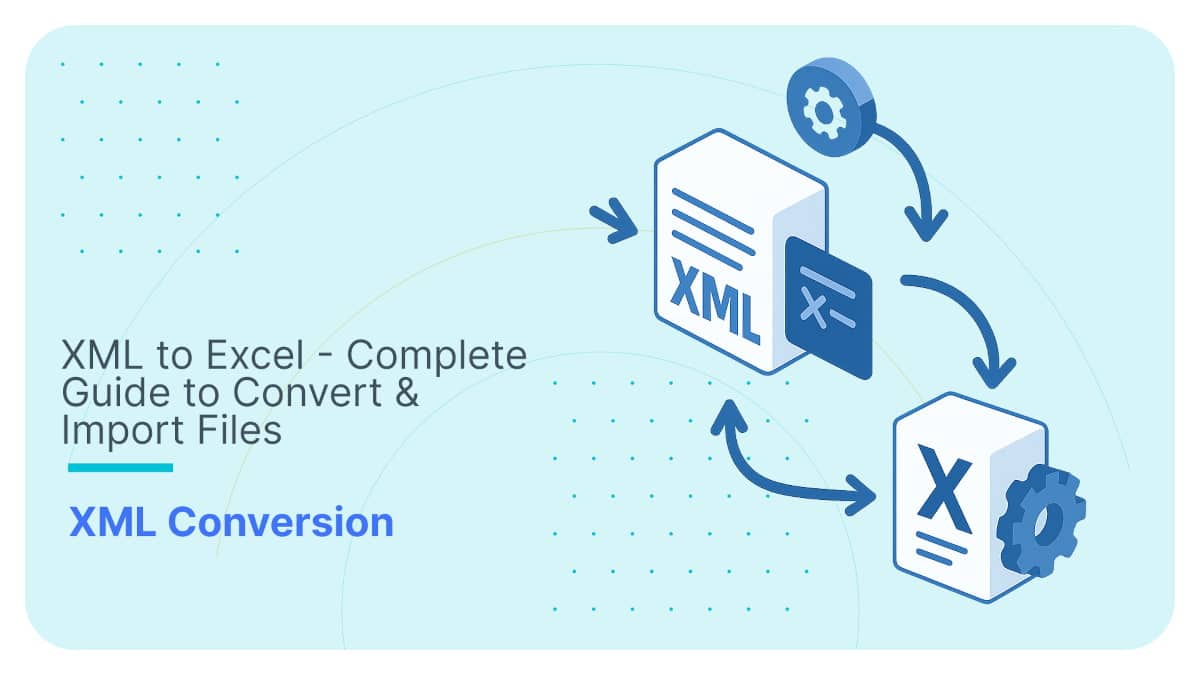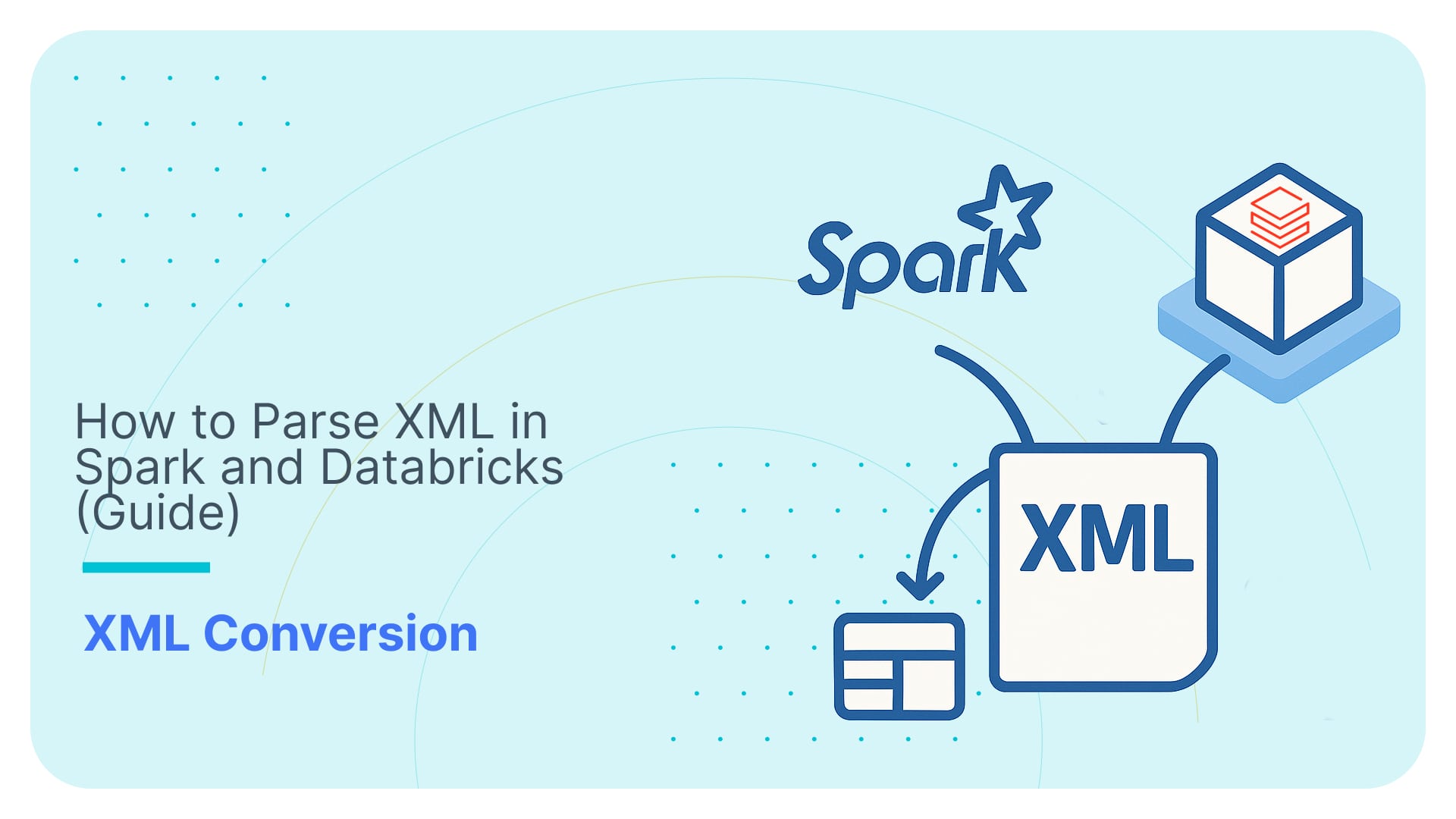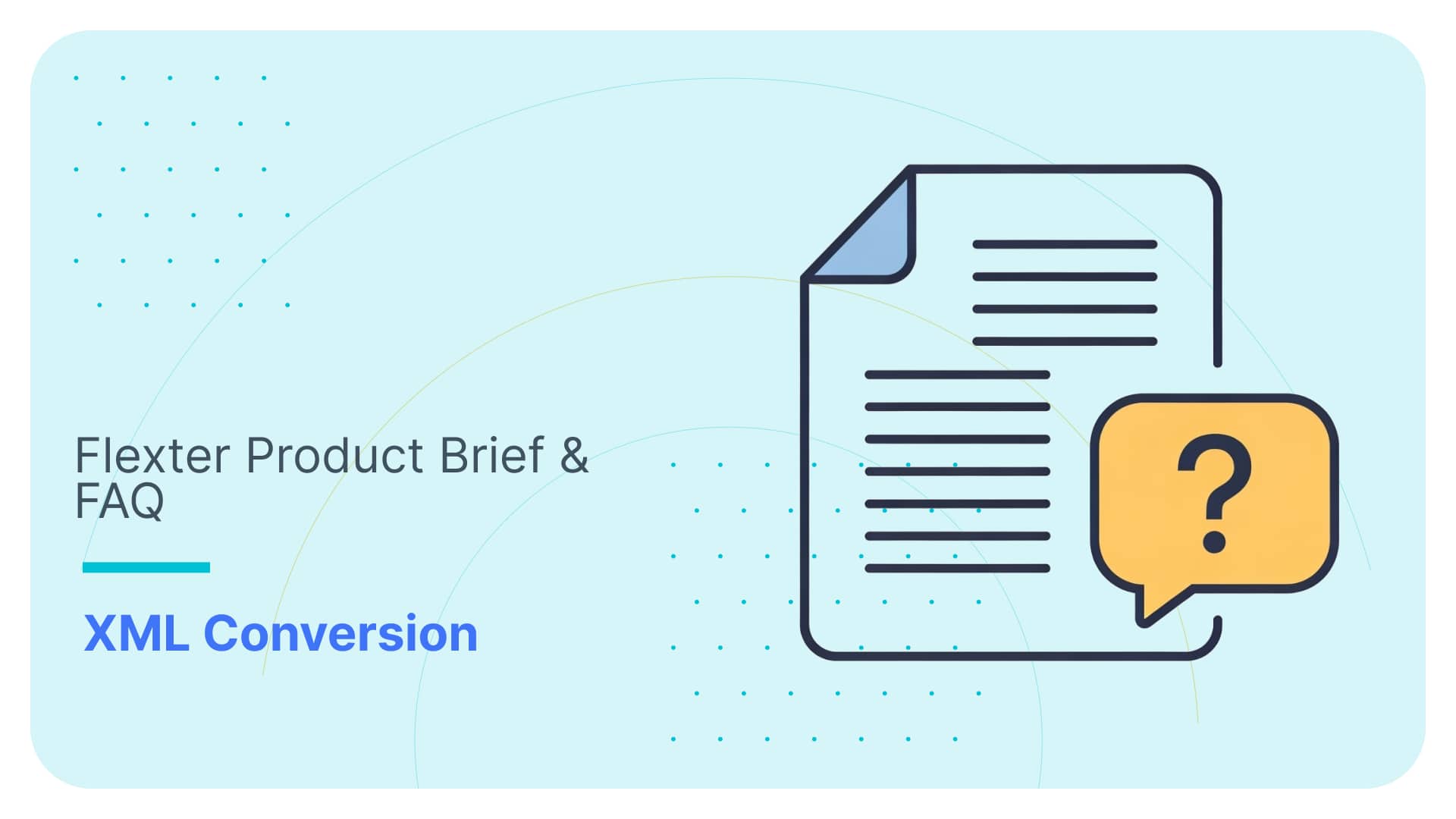9 Critical Types of XML Tools for Developers
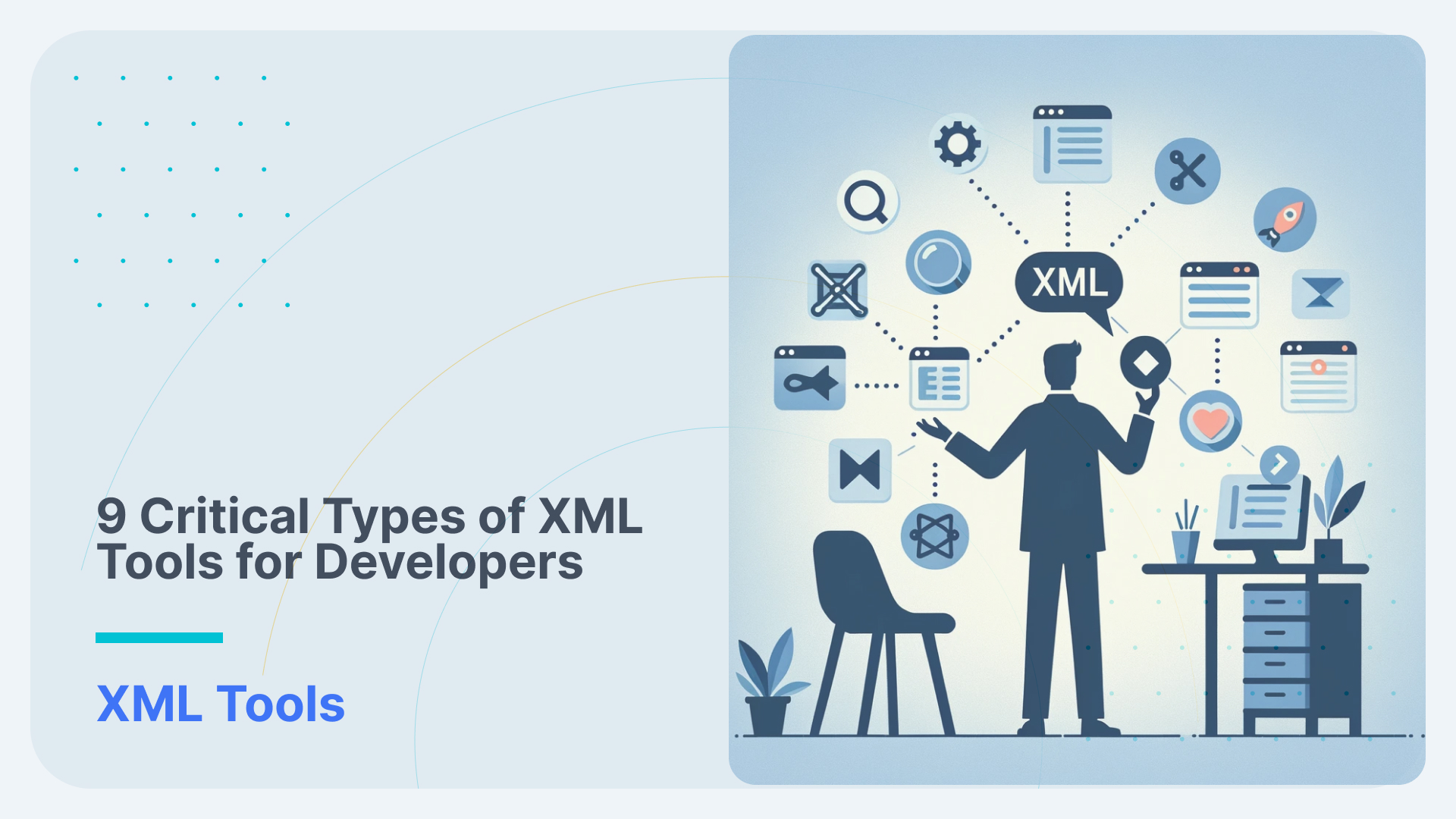
Trying to code XML and XSDs by hand is really tedious. It can be easy to mess up, especially with more complex XML based on industry data standards. XML software tools come to the rescue by automating many aspects of XML processing, such as validation, transformation, parsing, conversion, design, storage, querying and mapping. These tools significantly reduce manual effort, improve accuracy, and streamline workflows, making XML data management more efficient and less prone to mistakes.
The key players in XML software are XSD design tools and XML conversion tools.
XSD design tools provide a graphical interface, boosting productivity when creating complex schemas, especially those following industry standards.
Just like you wouldn’t build a database without setting up a schema first, it’s crucial to create and maintain an XML Schema Definition (XSD) when working with XML. This practice ensures your data is structured and consistent, similar to how relational databases operate.
On the other hand, XML conversion tools (aka XML mapping software) are vital for transforming XML into relational schemas for data analysis. While XML excels in data exchange and operational uses, it falls short in analysis and querying, which relational databases handle well. Conversion tools simplify this process, making them indispensable for working with intricate XML schemas.
Let’s dive into the different types of tools.
XML Conversion Tools
XML conversion is a two way street. XML conversion software that converts XML to other formats (like databases, relational models, JSON, CSV) or vice versa. Flexter is an example, known for converting XML to formats like Excel or a tabular format (CSV etc.). Most frequently organisations require to convert XML to a database such as conversion to MS SQL Server or Oracle. Another target for XML conversion are analytic databases such as Snowflake, BigQuery, Azure Synapse, or Redshift.
Use Flexter to turn XML and JSON into Valuable Insights
- 100% Automation
- 0% Coding
Our Ultimate Guide to XML Mapping in 2024 provides an in-depth exploration of automated XML mapping as an essential strategy for businesses to map and convert XML to other formats.
XML conversion tools replace the manual and traditional coding approach of converting XML documents. Some tools like Flexter fully automate the conversion process and cover the full XML conversion life cycle as illustrated in the following charts.

You also have the option to download a PDF that provides this side-by-side comparison of manual versus automated XML conversion.
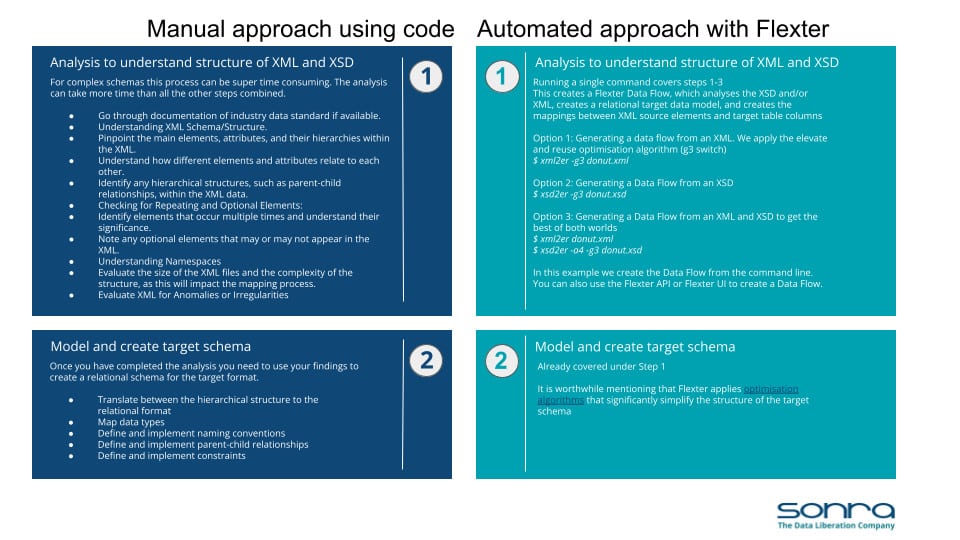
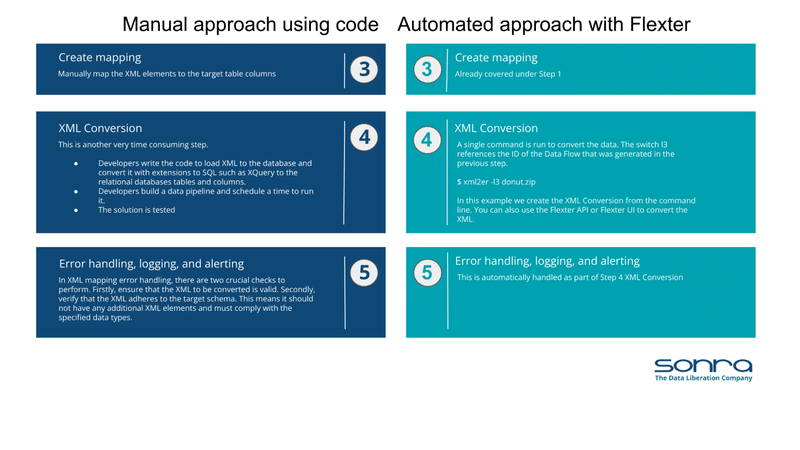
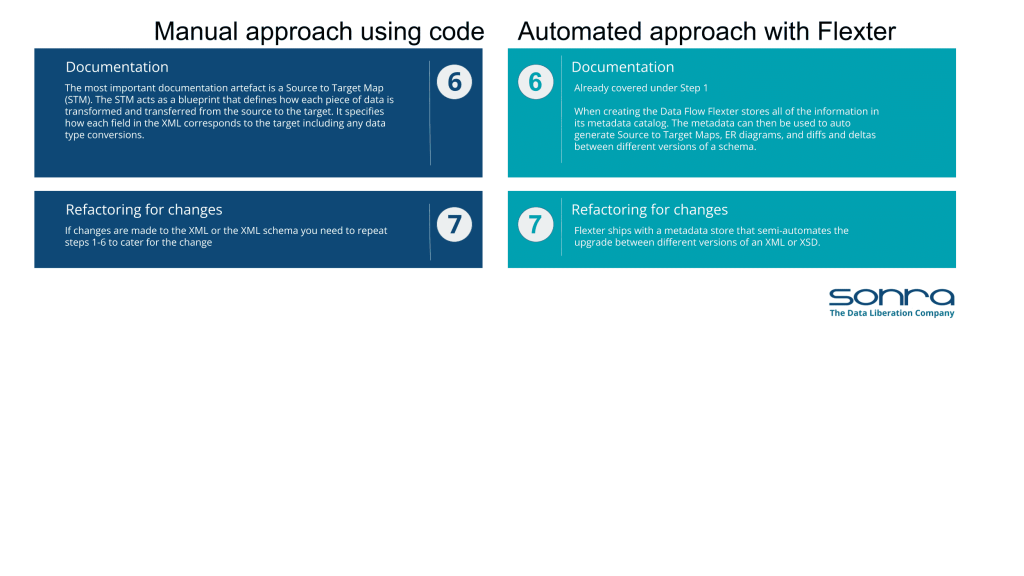
What are the advantages of using automated XML conversion?
From our experience, a large number of XML conversion projects fail or run over budget.
In the world of XML processing, automating XML parsing offers a bunch of benefits that make dealing with complex XML a breeze.
Let’s dive into the major advantages of going full automated with XML data processing:
- Complexity Management: An automated solution swiftly and effortlessly manages complexities in any XML and XSD, ensuring immediate processing.
- Accelerated Deployment: By automating the entire XML parsing process—including analysis, schema creation, and mappings—data swiftly gets in the hands of decision-makers.
- Risk Mitigation: Automating XML parsing minimises the likelihood of project delays or budget overruns in complex conversion projects, e.g. those adhering to industry data standards.
- Precision and Consistency: Automated parsing of XML ensures uniform and consistent operations, greatly reducing human error.
- Scalability: XML automation tools are designed to meet any service level agreement (SLA) and manage large volumes of XML data in a timely manner.
- User Accessibility: Automated tools feature intuitive interfaces, making XML processing more approachable and reducing reliance on specialised XML skills like XPath, XQuery, XSLT, which are scarce and can pose project risks.
When should you use an XML conversion tool?
If your XML tasks are straightforward or you’re just doing one-off queries, you might not need an XML automation tool. However, XML conversion software could be a great match for you if any of the following situations ring true:
- Is your XML super complex, uses an XSD, or follows industry data standards like HL7 or FpML?
- Do you need to convert various kinds of XML?
- Are your XML files really large?
- Do you need to process lots of XML data quickly to meet strict deadlines?
- Does your team not have much experience with XML technologies like XQuery, XSLT, and XPath?
- Are you under pressure to finish your XML conversion projects fast?
If you’re nodding yes to any of these, why not try out the free online version of our XML converter, Flexter? See for yourself how it can simplify your XML conversions. Or, if you prefer, get in touch with one of our XML conversion experts to chat about your specific needs.
XML Schema (XSD) Design Tools:
XML conversion tools are essential, but XML schema design tools are also critical. Creating XML documents without a schema is possible, but not advisable, even for straightforward projects. Just as no one would consider building a relational data model without a schema, adopting poor practices in XML projects should be avoided.
XML Schema Definition (XSD) tools are essential for XML development. They offer visual editing, code generation, and comprehensive validation, making them significantly more user-friendly than manual coding. These tools simplify the process of working with XML schemas, saving development time, minimising errors, and improving consistency and accuracy.
Key Features:
- Visual Editing: tools offer a graphical user interface to design schemas, allowing users to create and visualize structure of XML schemas without a need for coding
- Code Generation: some tools can generate XSD from XML documents or even generate entire XML documents that validate to a specific XSD
- Validation and Error Reporting: these tools generally include validation feature that does not only check for compliance with the schema, but also provide feedback of any errors
- Integration: some advanced tools may even provide an integration with some other development tools like IDEs, and thus provide seamless workflow
- Documentation Generation: useful feature that these tools provide is that they can generate documentation and make life of teams a lot easier to understand and work with XML documents
Examples of XSD design tools
Liquid XML Studio: This all-in-one package has everything you need for XML tasks, including tools to edit XML schemas (XSD) and XML files. It features a straightforward visual designer for schemas, making it simpler to check your XML files are correct and to create new ones. It also offers a limited and free community edition
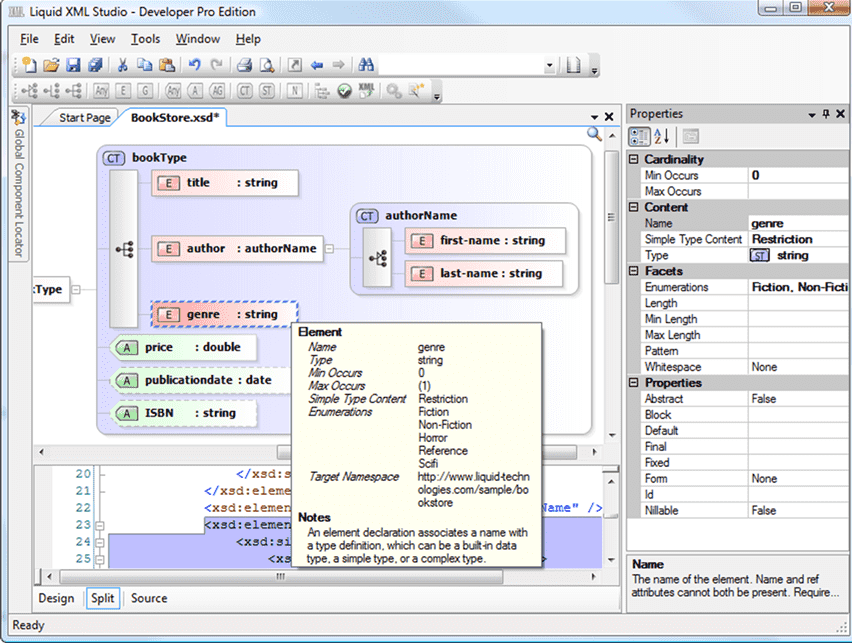
Oxygen XML Editor: Available for different computer systems, this tool is great for editing XML, designing XML schemas, and troubleshooting XSLT/XQuery issues. It comes with a strong schema editor that allows for easy visual modifications and ensures your XML files meet the right standards.
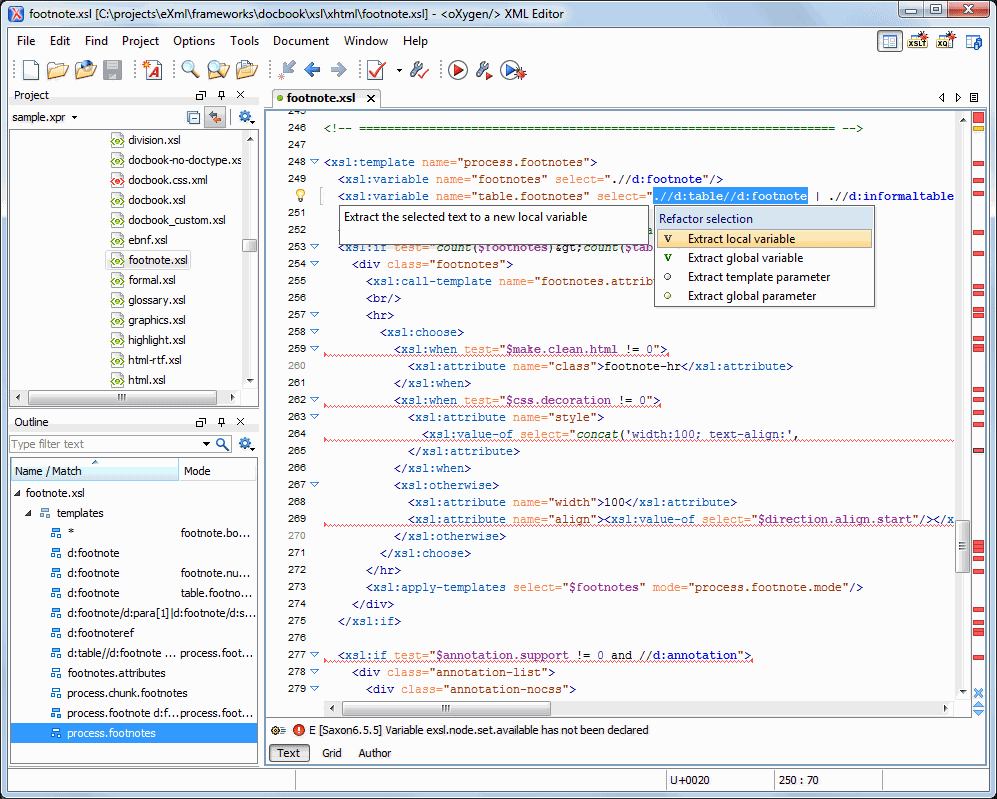
Eclipse XML Tools: This free, open-source set of tools is designed for developers who work with XML files within the Eclipse environment. It simplifies editing XML, creating XML schemas, and ensures your XML is correct. With its straightforward interface, you can easily navigate and edit your XML documents, making it a practical choice for anyone needing to handle XML files as part of their project.
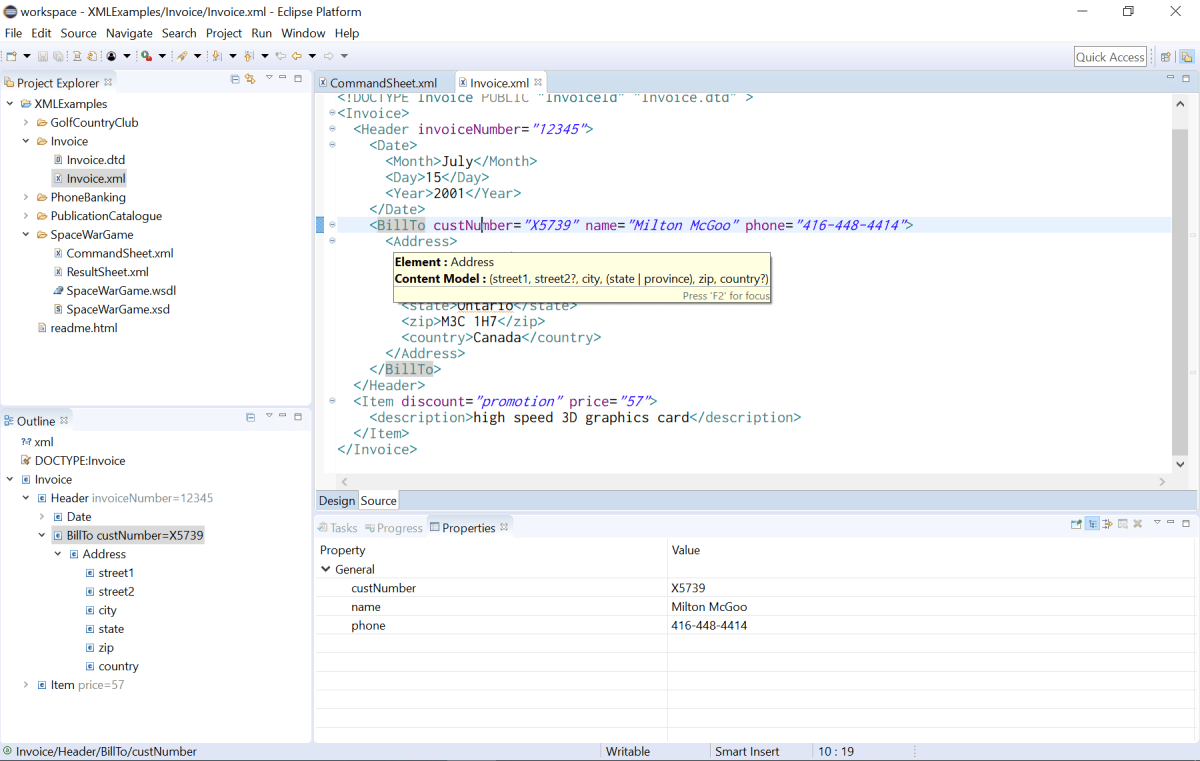
XSLT Processors:
The primary function of an XSLT processor is to apply XSLT stylesheets to XML documents. This process involves reading the XML source document and the XSLT stylesheet, and then generating a new document as output.
Step 1: Read the XML document
Step 2: Read the XSLT stylesheet
Step 3 Apply the XSLT stylesheet
Step 4: Generate the output
The output of an XSLT transformation can be in various formats. Although HTML and plain text are common outputs, XSLT processors can also produce XML, JSON, or any text-based format, depending on the instructions in the stylesheet.
Let’s go through a simple example that renders an XML document as HTML
Simple XML document
|
1 2 3 4 5 6 7 8 9 10 11 12 13 |
<?xml version="1.0" encoding="UTF-8"?> <bookstore> <book> <title>Harry Potter and the Sorcerer's Stone</title> <author>J.K. Rowling</author> <year>1997</year> </book> <book> <title>1984</title> <author>George Orwell</author> <year>1949</year> </book> </bookstore> |
|
1 2 3 4 5 6 7 8 9 10 11 12 13 14 15 16 17 18 19 20 21 22 23 24 25 26 27 28 29 30 |
<?xml version="1.0" encoding="UTF-8"?> <xsl:stylesheet version="1.0" xmlns:xsl="http://www.w3.org/1999/XSL/Transform"> <xsl:template match="/"> <html> <head> <title>Bookstore</title> </head> <body> <h1>Available Books</h1> <table border="1"> <tr bgcolor="#9acd32"> <th>Title</th> <th>Author</th> <th>Year</th> </tr> <xsl:for-each select="bookstore/book"> <tr> <td><xsl:value-of select="title"/></td> <td><xsl:value-of select="author"/></td> <td><xsl:value-of select="year"/></td> </tr> </xsl:for-each> </table> </body> </html> </xsl:template> </xsl:stylesheet> |
The <xsl:for-each select=”bookstore/book”> element iterates over each <book> element in the XML.
The <xsl:value-of select=”…”/> extracts the values of the title, author, and year elements from each book and places them in the HTML table.
Did you know?
XSLT processors use XPath, a language for navigating XML documents, to identify parts of the XML document that match the patterns defined in the XSLT stylesheet. XPath expressions are used within XSLT to select nodes, calculate values, and set conditions.
A popular open source XSLT process is Xalan. Java and C++ versions are available.
A popular commercial XSLT processor is Saxon from Saxonica. It offers advanced features over Xalan and supports XSLT 2.0 and even XSLT 3.0.
XML Editors:
XML editors are tools that are used to open, update, delete, create, view XML documents. They are specifically created to understand XML, and to work with XML structure, providing several key functionalities like syntax highlighting and validation, tree view and hierarchical editing, content assistance and auto-completion, formatting and beautification etc.
- Syntax Highlighting and Validation: XML editors ensure that the XML document adheres to the rules of XML syntax. They can automatically detect and highlight errors, helping users to correct them and maintain well-formed XML documents.
- Tree View and Hierarchical Editing: Many XML editors offer a tree view of the XML document, which represents the hierarchical structure of the XML elements. This view makes it easier to navigate complex documents and understand their structure.
- Content Assistance and Auto-Completion: XML editors often provide content assistance features like auto-completion of tags and attributes, which speeds up the editing process and helps to avoid typos and syntax errors.
- Formatting and Beautification: They can automatically format and indent the XML content for better readability and organisation.
There are two types of XML editors
Simple text editors provide basic XML editing with syntax highlighting.
Dedicated XML editors like Oxygen XML Editor, and Xmplify offer advanced features like validation, transformation, and auto-completion.
Text editors provide simple features but are also easy to learn. Examples are Notepad++, Sublime Text, Visual Studio Code etc. Notepad++ offers plugins for some advanced features like XML validation.
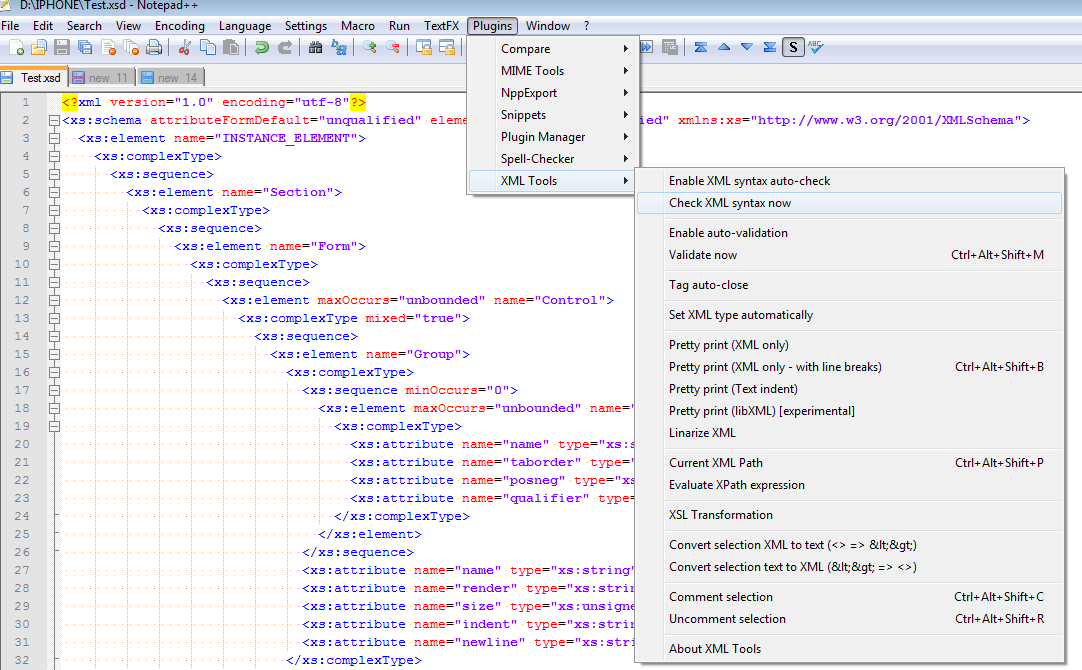
There are also dedicated XML editors that offer more advanced features like validation, transformation and auto completion.
In the image below we can see the completion feature of Oxygen XML Editor.
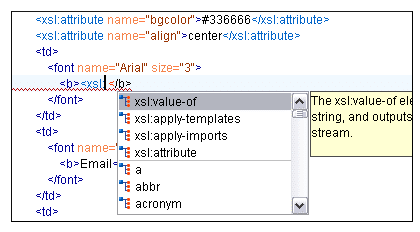
Pros and Cons of XML Editors:
Pros:
- Efficiency: Speeds up the process of editing and validating XML files.
- Accuracy: Reduces errors in XML documents.
- Ease of Learning: Intuitive interfaces make it easier for beginners to work with XML.
Cons:
- Cost: Some advanced editors can be expensive.
- Resource Intensive: Some editors may require significant system resources, especially for large documents.
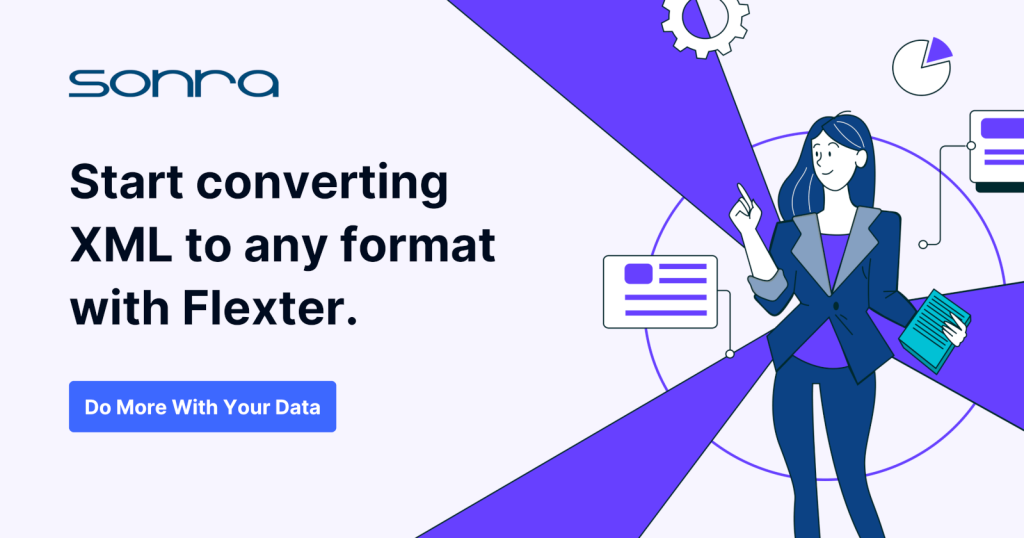
XML Validators:
XML validators have a crucial role in ensuring that XML files comply with standards and rules defined for XML structures. XML validators have two main functions, checking for well-formedness and validating XML against XSD or DTD.
Did you know?
XSD, which stands for XML Schema Definition, is a language used for defining the structure, content, and semantics of XML documents. Purpose of XSD is to impose rules onto XML documents, and ensure that they are following a defined set of requirements. XSD is created as a separate document.
DTD is an older solution of imposing a set of requirements onto XML documents. It can be written inline inside an XML document, but it offers a limited amount of features compared to XSD.
Well-formedness
First XML files get checked if they are complying to basic XML rules like usage of proper closing tags, correct nesting of elements and usage of correct characters.
Validating against an XSD or DTD
After a basic check is done, validators also can ensure that XML files are complying with the DTD or schema files. That involves checking that the document structure, element names and attributes match the defined schema or DTD
There are various types of XML validators. Online based, built into XML editors and standalone XML validators.
One of the standalone validators is XMLLint. It is a command-line tool used to validate XML files against a schema (XSD).
Validating an XML with XSD can be done with the following code:
|
1 |
xmllint --noout --schema ~/Downloads/book.xsd ~/Downloads/book.xml |

XML Parsers:
XML parsers are tools that read the XML documents and translate them into a form that is easy to work with programming languages like JAVA, Python etc, and thus provides an access to programmatically access and manipulate XML data.
There are two main types of XML parsers, DOM parsers and SAX parsers.
DOM Parsers
Dom parsers provide a tree representation of XML documents. This tree mirrors the structure of the XML, with nodes representing elements, attributes, text, etc, and provides the ability to navigate through them.
SAX Parsers
SAX is an event-driven model. As the parser reads through the XML document sequentially, it triggers events (like starting an element, ending an element, finding characters) that the application can respond to with custom handlers.
An XML parser is one of the components used in an XML conversion tool. Our own XML converter Flexter uses a SAX parser as we achieve much better performance than with DOM.
Difference between DOM Parsers and SAX Parsers
The main difference between DOM and SAX parsers, is that DOM parsers load entire XML documents into memory, and because of that they are memory heavy. However, they are more intuitive and easier to use.
SAX parsers are optimised for read-only access, memory efficiency, and speed in processing large XML files, while being a lot less intuitive and harder to use.
Use a DOM parser when the task involves accessing or modifying parts of an XML document randomly, as it loads the entire document into memory, allowing for easy traversal and manipulation. Opt for a SAX parser for processing large XML files or when memory efficiency is crucial, as it reads the document sequentially and doesn’t store the entire tree in memory, making it faster and less memory-intensive but without the ability to modify the document content.
XML Browsers and Viewers:
XML Browsers and Viewers are tools designed to make working with XML data a lot more manageable and user-friendly. Since raw XML code can be tough to sift through, especially when you’re dealing with complex or voluminous data, these tools step in to help you visualise and navigate XML documents with ease.
XML Browsers: These are usually web browsers or browser extensions that can interpret and display XML documents directly. They present XML files in a structured, easy-to-read format, often with collapsible elements and syntax highlighting. Some browsers might also transform XML data using XSLT (Extensible Stylesheet Language Transformations) to render it in a more human-readable form, like HTML.
XML Viewers: These are standalone applications or software components designed specifically for viewing and navigating XML files. They offer features like pretty-printing (nicely formatting the XML code with indents), syntax highlighting (making different parts of the XML code stand out with colours), and tree views (showing the hierarchical structure of the XML document in a clear, collapsible format).
Benefits of using XML browsers and viewers
Simplified Document Navigation
With XML Browsers and Viewers, navigating through an XML document becomes significantly easier. Elements, attributes, and their hierarchies are presented in a clear, visual format, allowing users to quickly find the information they need.
Enhanced Readability
Syntax highlighting and pretty-printing break the monotony of plain text, distinguishing elements, attributes, and text content. This not only makes XML documents easier to read but also helps in quickly identifying parts of the document.
Error Identification
Many XML Viewers come equipped with validation tools that can identify and report errors in your XML document. Whether it’s a missing tag or a misapplied attribute, these tools help maintain the integrity of your XML documents.
Development and Debugging
For developers, XML Viewers integrated into IDEs provide a seamless way to work with XML files alongside their project code. Features like XPath evaluation and XSL transformations are indispensable for debugging and developing complex XML-based applications.
Popular XML Browsers and Viewers
Firefox and Chrome
Modern web browsers like Firefox and Chrome can natively open XML files, offering basic functionalities for viewing and navigating XML documents.
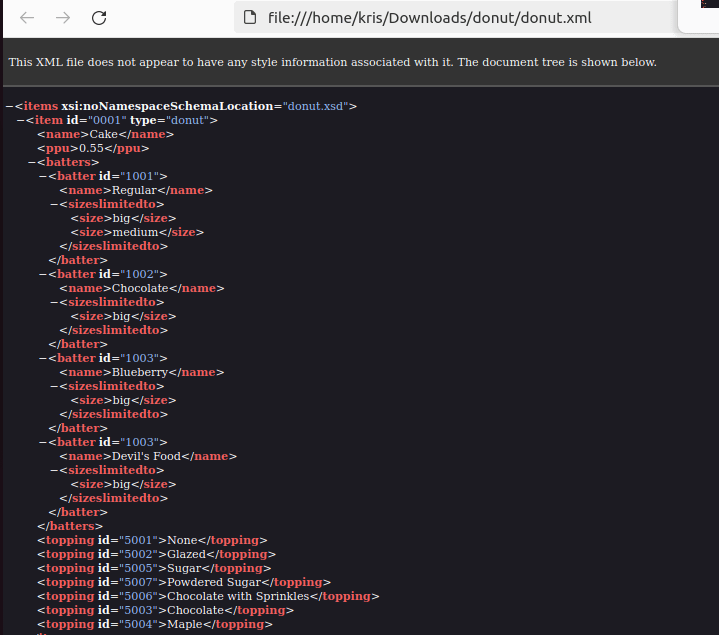
XML Explorer
XML Explorer is a very fast and lightweight tool for viewing XML files. It is particularly useful for working with large XML files, providing features like multiple document tabs, copying of formatted XML data, and XPath expression evaluation. The application excels in speed, and offers a user-friendly interface that includes support for expanding and collapsing elements, similar to the features found in Visual Studio 2005 but with improved performance for large files
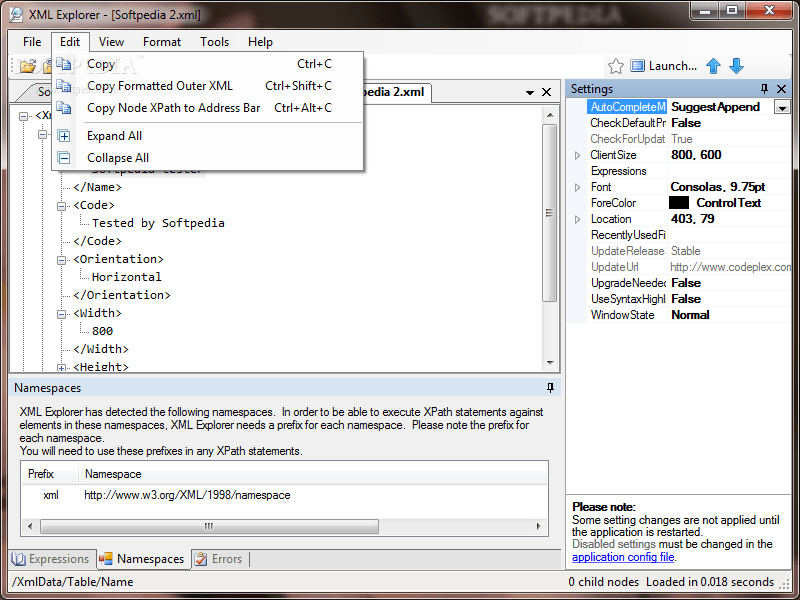
MindFusion XML Viewer
The MindFusion XML Viewer is a powerful, yet lightweight tool designed for viewing and editing XML files. It offers a user-friendly interface, fast performance, and has been completely rewritten to include new features like colour-coded XML trees, node wrapping, bookmarks, line numbers, and SVG file rendering. Suitable for both personal and business use, the XML Viewer is available for free for non-commercial purposes, with a cost-effective licensing option for businesses
XML Databases:
XML databases are databases specifically designed for XML data. They are created to handle the hierarchical, flexible structure of XML documents. Some of the key features that XML databases provide are:
- Flexible Data Modeling: XML databases can easily adapt to changes in document structure, making them ideal for unstructured or semi-structured data.
- Support for XML Standards: They inherently support XML standards, including XPath, XQuery, and XSLT, allowing for powerful querying and transformation capabilities.
- Full-Text Search: Many XML databases offer robust full-text search capabilities, making it easier to perform complex queries involving the content of the XML documents.
There are two different versions of XML databases XML-Enabled Databases and Native XML Databases (NXD).
XML-Enabled Databases
XML-enabled databases are traditional relational or object-relational databases that offer support for XML data, e.g. Oracle or SQL Server XML data types. We have written about converting XML to a relational format on Oracle and parsing XML in SQL Server
Native XML Databases (NXD)
BaseX: BaseX is an open-source XML database engine and XQuery 3.1 processor known for its lightweight nature and high performance. It supports W3C Update and Full Text extensions, making it suitable for complex, data-intensive web applications. BaseX offers interactive user interfaces for both desktop and web-based environments, providing deep insights into data management and processing

eXist-db: eXist-db is an open-source NoSQL database system built on XML technology, providing support for XML, JSON, HTML, and binary documents. It’s unique for offering XQuery and XSLT as its query and application programming languages, distinguishing it from most relational and NoSQL databases.
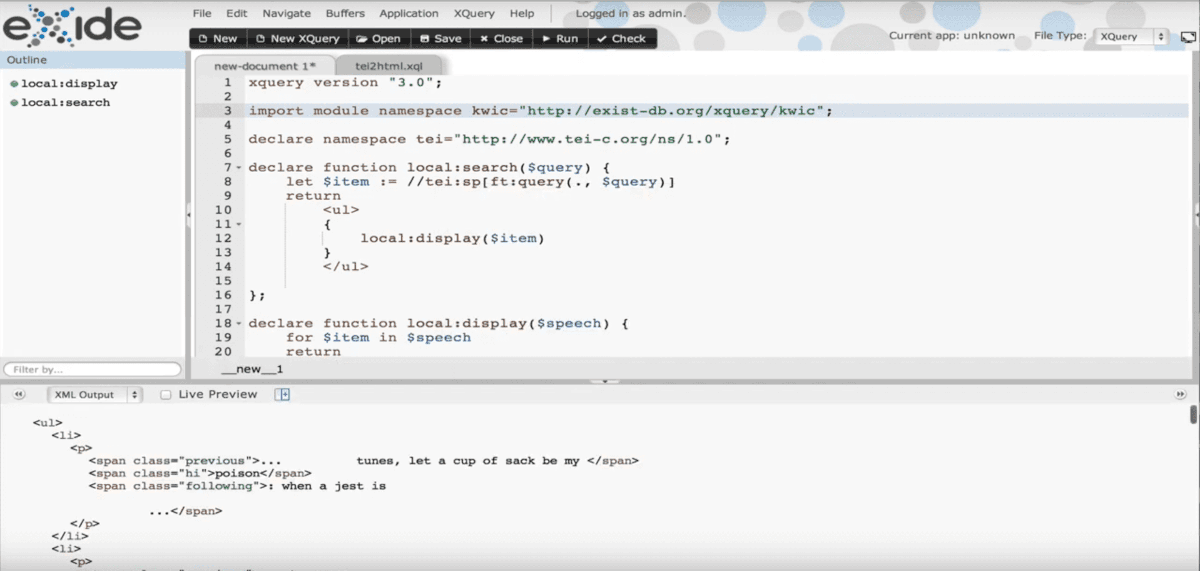
MarkLogic: While not open-source, MarkLogic is a NoSQL database that specialises in handling XML content among other data types. It offers robust features for storing, searching, and managing XML, making it suitable for enterprise-level applications dealing with large volumes of data. MarkLogic combines the flexibility of document-based storage with the search and query capabilities.
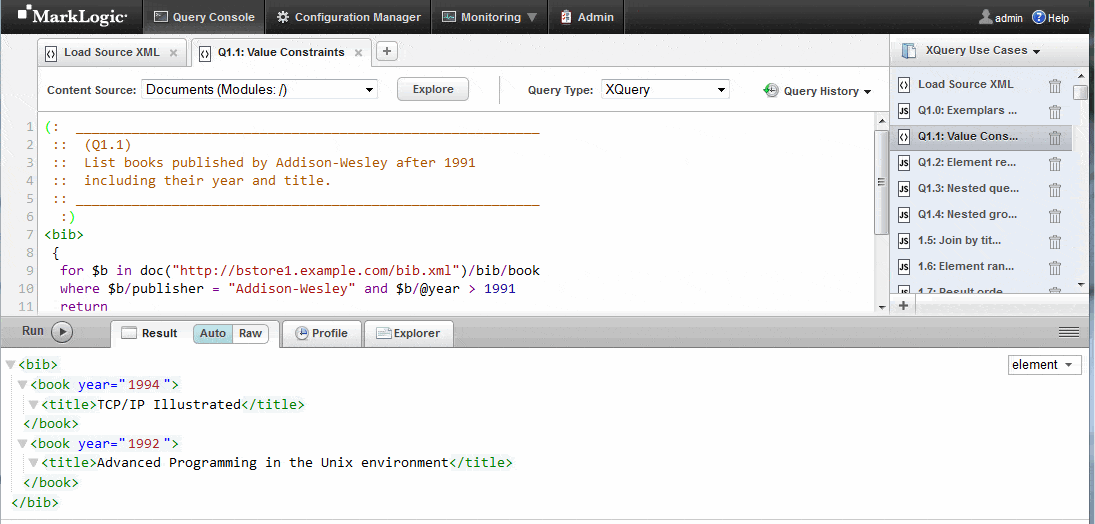
XML Diff Tools:
XML Diff Tools are specialised software applications designed to identify differences between two XML documents. These tools are essential in various scenarios, such as version control, where tracking changes between document versions is crucial, or in data integration processes, where identifying discrepancies in data exchanged between systems is necessary.
Key Features
- Element and Attribute Comparison: They can detect differences in both the elements and attributes of XML documents, including changes in element values, additions or deletions of elements, and modifications to attributes.
- Structural Awareness: These tools understand the hierarchical structure of XML documents, allowing them to accurately compare documents even if their elements are reordered.
- Visualisation: Many XML Diff Tools provide a visual representation of differences, highlighting them in a side-by-side or inline view, making it easier to understand and analyse discrepancies.
- Merging and Editing: Some advanced tools offer features to merge differences or edit the documents directly within the tool, facilitating quick resolutions to discrepancies identified during the comparison.
- Filtering and Customization: Users can often filter out certain types of differences or customise comparison rules, which is useful for focusing on meaningful changes and ignoring trivial differences like whitespace or comments.
Popular XML Diff Tools
Flexter, our XML conversion tool, simplifies XML change management by comparing different versions of XML documents and XSDs, crucial for adapting to new versions of industry data standards, like updating from FpML 5.1 to 5.2. It initially assesses the impact on the relational target schema by comparing XML versions. Then, leveraging the Flexter Metadata Catalog, it automates the upgrade of the target schema, streamlining the update process for downstream processes that rely on the FpML XML documents.
DeltaXML is a suite of software tools designed for comparing and merging XML and JSON files. It is known for its structural awareness, highly configurable output formats, and comprehensive APIs. DeltaXML supports complex comparison and merging scenarios, making it suitable for integration with content management workflows or existing editing and publishing products. Its rich API facilitates customization to highlight changes that matter most to the user.
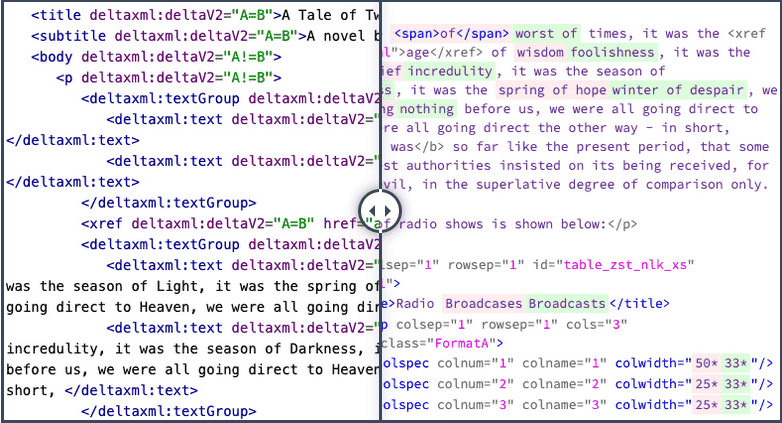
ExamXML is a visual XML diff tool developed by A7Soft, designed for comparing and merging XML documents. It features a tree view for displaying XML documents, highlighting differences at the level of elements, words, or attributes in color to indicate changes, deletions, or additions. ExamXML supports extensive comparison options, validation against DTD/XML Schema, and normalisation of dates and numeric fields. It also offers editing capabilities within the XML documents, saving differences or similarities, and advanced options for ignoring specific XML elements based on conditions set by the user
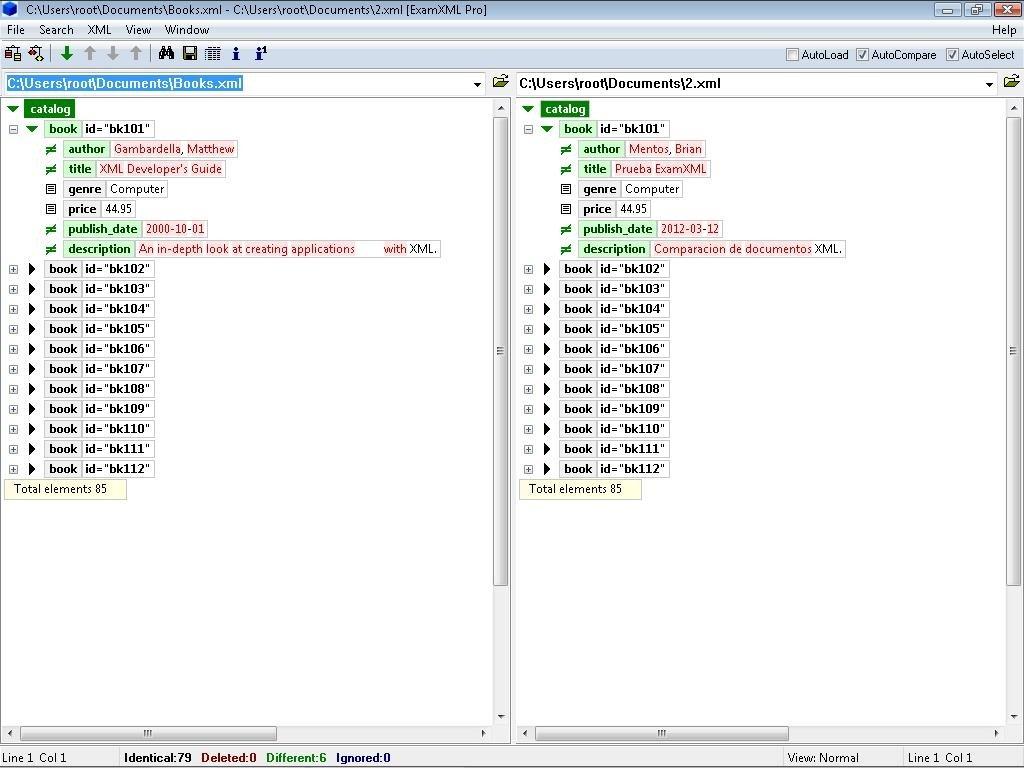
Masking PII data
Masking PII is a critical data protection technique used to safeguard personal information from unauthorised access. The primary goal is to prevent data breaches and protect individuals’ privacy by making the data unreadable or inaccessible to those without the necessary permissions. Masking PII data can be effectively accomplished using methods such as redaction (entire removal of sensitive information), anonymization (stripping data of identifiable traits), pseudonymization (substituting private identifiers with pseudonyms), and encryption (encoding data to restrict access to authorised users only).
Masking PII data in XML
XML, widely utilised for its ability to store and transmit structured data across numerous platforms, plays a critical role in configurations, web services, and data exchange. This widespread use necessitates stringent measures for masking PII data effectively within XML documents. However, the inherent complexity of XML’s hierarchical structure, characterised by nested elements and attributes, poses distinct challenges for the masking process, making it notably more demanding than in more straightforward, flat data structures.
Paranoid
Paranoid is a powerful tool designed for masking, anonymizing, and obfuscating Personally Identifiable Information (PII) in XML and JSON data. It addresses privacy concerns by transforming sensitive data into a format that protects individual identities, ensuring compliance with data protection regulations while maintaining the utility of the data for analytical purposes. Paranoid offers a flexible solution for organisations looking to safeguard their data assets against privacy risks.
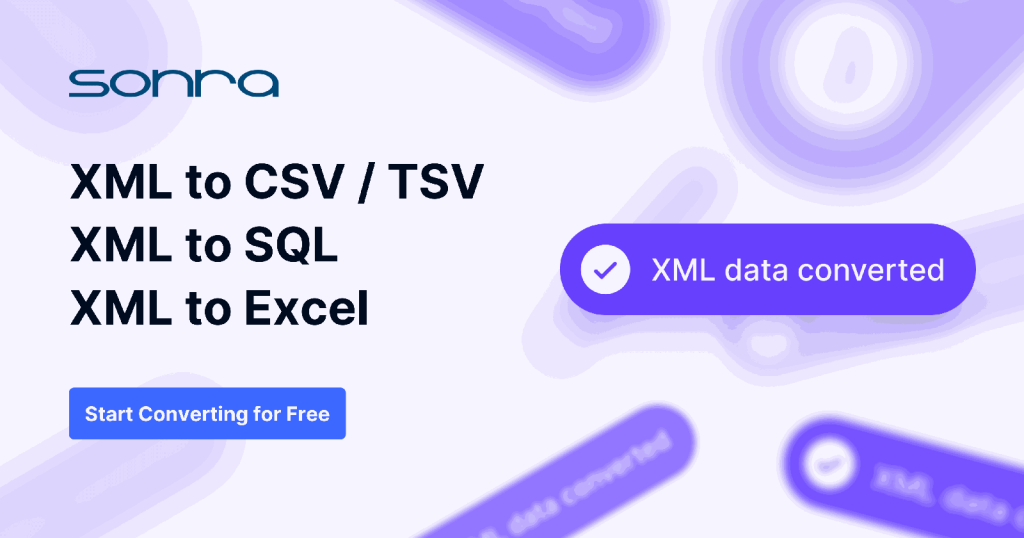
Using the right XML tools for your use case
Will you need the full set of XML tools mentioned in our blog post? Probably not. As with everything it boils down to your specific scenario. You won’t need to mask PII if your XML docs don’t contain personal data. You won’t need to worry about XML parsing if you don’t want to build your own XML conversion tool (and by the way you shouldn’t).
Don’t build your own XML converter
“Because of such inherent complexity, never plan on writing your own XML processing interface to parse XML documents.
The structure of an XML document is quite involved, and the construction of an XML parser is a project in itself—not to be attempted by the data warehouse team.”
Kimball, Ralph: The Data Warehouse ETL Toolkit. Practical Techniques for Extracting, Cleaning, Conforming, and Delivering Data
You won’t need a native XML database if XML is not pervasive throughout your organisation.
You need to think about your use case and the tools that are right.
Critically, you need to make sure your XML data is accessible for data analysis in the right format. This is why XML converters are such a powerful and foundational tool for making the most of your XML data.
Get in touch to talk about Flexter and the right XML tools for you.



